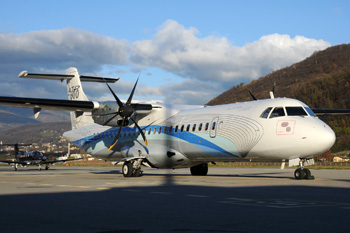INDIAN ARMED FORCES CHIEFS ON
OUR RELENTLESS AND FOCUSED PUBLISHING EFFORTS

SP Guide Publications puts forth a well compiled articulation of issues, pursuits and accomplishments of the Indian Army, over the years

I am confident that SP Guide Publications would continue to inform, inspire and influence.

My compliments to SP Guide Publications for informative and credible reportage on contemporary aerospace issues over the past six decades.
ATR has a good outing

ATR, the regional aircraft manufacturer, has had a good show at the 51st Paris International Air Show, having bagged 46 firm orders and 35 options, for a total value of USD 1.98 billion dollars. The orders coming from airlines from the five continents were signed at the show, signalling that ATRs were the year’s best-selling regional aircraft with fewer than 90 seats, despite a difficult economic and financial context and a highly competitive environment. Sales since the beginning of the year have enabled ATR to break through the symbolic barrier of 1,500 firm orders and to consolidate an order book of nearly 300 aircraft, the equivalent of over three years of production.
Speaking to SP’s, the new Chief Executive Officer of ATR, Patrick de Castelbajac said he was “highly satisfied with the results obtained. The ATRs are once again firmly established as the favourite aircraft of regional airlines worldwide. Despite the rise in the value of the dollar and the economic slowdown in countries that are very important for our business, we have managed to preserve our position as the number one choice for the airlines”.
The ATR CEO had a brief interaction with India’s Civil Aviation Minister, Ashok Gajapathi Raju and the latter mentioned to him how the Indian government was laying emphasis on regional connectivity. To which Mr. Castelbajac pointed out that ATR was the best bet for short haul routes. Mr. Castelbajac told SP’s that though he was new to the CEO post of ATR, he was aware of the immense potential the Indian aviation market held. “ATR can play a big role in expanding regional aviation in India. I will be in New Delhi soon for the IATA conference and my focus will be on how to connect pan-India through regional airlines.”
Castelbajac said globally the company was “estimating demand for about 2,500 turboprops in the coming twenty years and we must continue to develop our range of aircraft and the associated services, in order to remain the reference regional aircraft manufacturer.”
He said that there were many markets which needed to be looked at closely and that included China. “We have opened two new offices in Beijing and Tokyo, to ensure greater reactivity on two markets offering very significant potential for the development of regional air networks with turboprops.” At the show, ATR presented the new High Density version of the “Armonia” cabin, capable of accommodating up to 78 passengers (in place of the current 74), in response to demand from certain airlines. The “High Density” cabin should receive certification before the end of the year, for service entry in 2016.
ATR which is an equal partnership between two major European aeronautics players, Alenia Aermacchi (a Finmeccanica group company) and Airbus Group is investing substantially in enhancing the turboprops. ATR announced deployment of a new, improved vision system, available for the first time on a commercial aircraft. The “Clear Vision” system provides the pilots with head-up information about the flight, directly to the eyes, by means of a device, the Skylens, worn on the face. The increased visibility obtained with the Skylens also enables minimum landing distances to be reduced. This new system thus proposes an extremely reliable alternative for CATIII landings at airports not equipped with instrument landing systems (ILS).
Among the other innovations concerning the versatility and operational reliability of its latest generation of aircraft, ATR presented a new wind shear detection system, besides the installation of new ATR ‘-600’ avionics systems, for even more precise airport final approaches (RNP 0.3/0.3).
As part of its participation in the “Clean Sky” project, a European initiative which aims to develop technologies to reduce gas emissions and noise from tomorrow's aircraft, ATR announced that an ATR 72 prototype will be carrying out the very first test flight for the project in the next few days. ATR is playing an active role in the Green Regional Aircraft program. This first flight test campaign should be able to test new, lighter and more insulating composite materials and vibro-acoustic sensors installed on a section of the aircraft’s fuselage. Improvements in terms of lower weight and reductions in fuel consumption and CO2 emissions by the ATR 72 should eventually benefit the regional aircraft of tomorrow. These flights will also be able to test the new generation of optical fibres for improved identification of micro-cracks and easier maintenance.





